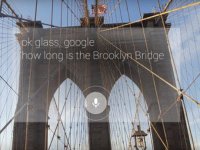The Future of Education as Seen Through Google Glass
"OK, Glass . . . reform education." (If only it were that easy.)
I've been lucky to be a member of the Google Glass Explorer Program for the past month, and this device has my attention. I was skeptical of Glass upon first hearing about the new technology, but as it developed, I began to see the potential not only in education, but also for the contemporary consumer. At this juncture, Glass is limited and very expensive. However, it has potential in what we do as educators.
Andrew's-Eye View
My first day with Glass was interesting, to say the least. When I left for work that morning, I made sure I was wearing Glass. I slipped it on as I gathered my things, and proceeded to record video of what it looks like when I walk out the door for work every morning. Exciting, I know. However, I did send this to my parents in case they ever wondered how I start my day and what it looks like from a first person viewpoint.
The first time I wore Glass in a classroom, it was unannounced. It was during the Hour of Code, and students at Florence Roche Elementary School were getting an introduction to coding using various web-based programs. As I walked in, students became immediately distracted. I initiated a question-and-answer forum around what they were doing and had several students enlighten me on what coding meant and why it was being addressed in a fourth grade classroom. Eventually, one bright student raised his hand and said, "Are those Google Glasses on your face?"
So how does Glass fit into the education technology conversation? I'll share a few examples.
Glass in Action
Soon after seventh grade English teacher Jennifer Leung was informed about Glass, she had me bring the device to her class at Groton-Dunstable Middle School. Her students had just finished reading Charles Dickens' A Christmas Carol and were about to embark on a project. The assignment was to create a tableau for a scene in the text. In groups, students collaborated via a Google doc and addressed questions that Mrs. Leung created ahead of time. Once this was completed, students gathered props and staged their scenes. Someone from another group used Glass to provide firsthand documentation of the tableau with a still image. That student also took a short video of the scene and uploaded it to YouTube.
While this same task could have easily been done with an iPad or iPhone, the students reveled in the experience of using Glass for the project. They also liked the ease of using this wearable device and the firsthand perspective it provided.
Another example I found from Nick Provenzano, a fellow Edutopia blogger, shows how teachers can leverage this tool for feedback in the classroom. Nick had one of his students wear Glass while he was teaching and record a video of the class. For an administrator, this provides a firsthand account of not only what the teacher is teaching, but what the student is doing while the teaching is happening.
At Groton-Dunstable, we are using Evernote for the Massachusetts education evaluation program that started integrating across all districts in the state last year. Evernote is also an app (or Glassware) that is integrated with Glass. Teachers are starting to use Glass for pieces of their class that they'd like to capture, archive and push to Evernote for their goals.
At Swallow Union Elementary School, Jen Marino is putting together a project for her third grade students that integrates Glass and has students leveraging the technology for solving math problems and reflection on the process. They will be wearing Glass while solving an area problem using color tiles. They'll film the process via Glass, providing a voice-over as they walk through the problem. Students who have difficulty with determining the area will now also have an option for further learning. These videos can be pushed directly to YouTube, made private, and emailed home to parents for further practice.
The Exploration Continues
And we’re just scratching the surface with this new, exciting tool. Part of being a Glass Explorer is being on the bleeding edge of education technology. To some, this device might seem like a silly waste of time and resources. However, the potential is there. Yes, I also felt like Google Wave was going to be a great tool that fostered collaboration and connected us all within a greater community for sharing and learning, and I apologize for the hype. However, I foresee Glass taking off in schools as an assistive technology, as a creation tool and as a reflection tool. The jury is still out on Glass, and we have lots to explore.
The underlying theme in all of this is that an explorer doesn't take the path that's been traveled most -- he or she develops the path and, at the risk of failure, shows others the way. And for that, Glass will make great strides in an educational context and present some exciting new opportunities for teaching and learning. If you’d like to see these examples and more, join our Google+ Community.
And if you have experience with or questions and concerns about Google Glass, please share in the comments section below.
